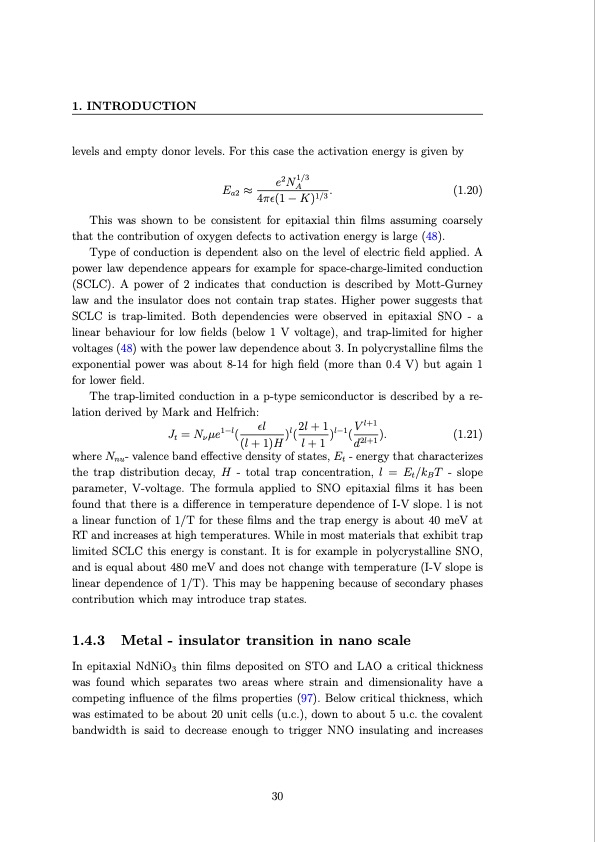
PDF Publication Title:
Text from PDF Page: 051
1. INTRODUCTION levels and empty donor levels. For this case the activation energy is given by e2N1/3 Ea2 ≈ A . (1.20) This was shown to be consistent for epitaxial thin films assuming coarsely that the contribution of oxygen defects to activation energy is large (48). Type of conduction is dependent also on the level of electric field applied. A power law dependence appears for example for space-charge-limited conduction (SCLC). A power of 2 indicates that conduction is described by Mott-Gurney law and the insulator does not contain trap states. Higher power suggests that SCLC is trap-limited. Both dependencies were observed in epitaxial SNO - a linear behaviour for low fields (below 1 V voltage), and trap-limited for higher voltages (48) with the power law dependence about 3. In polycrystalline films the exponential power was about 8-14 for high field (more than 0.4 V) but again 1 for lower field. The trap-limited conduction in a p-type semiconductor is described by a re- lation derived by Mark and Helfrich: 1−l εl l 2l+1l−1 Vl+1 Jt =Nνμe ((l+1)H)( l+1 ) (d2l+1). (1.21) where Nnu- valence band effective density of states, Et - energy that characterizes the trap distribution decay, H - total trap concentration, l = Et/kBT - slope parameter, V-voltage. The formula applied to SNO epitaxial films it has been found that there is a difference in temperature dependence of I-V slope. l is not a linear function of 1/T for these films and the trap energy is about 40 meV at RT and increases at high temperatures. While in most materials that exhibit trap limited SCLC this energy is constant. It is for example in polycrystalline SNO, and is equal about 480 meV and does not change with temperature (I-V slope is linear dependence of 1/T). This may be happening because of secondary phases contribution which may introduce trap states. 1.4.3 Metal - insulator transition in nano scale In epitaxial NdNiO3 thin films deposited on STO and LAO a critical thickness was found which separates two areas where strain and dimensionality have a competing influence of the films properties (97). Below critical thickness, which was estimated to be about 20 unit cells (u.c.), down to about 5 u.c. the covalent bandwidth is said to decrease enough to trigger NNO insulating and increases 4πε(1 − K)1/3 30PDF Image | Investigation of metal-insulator transition in magnetron sputtered samarium nickelate thin films

PDF Search Title:
Investigation of metal-insulator transition in magnetron sputtered samarium nickelate thin filmsOriginal File Name Searched:
Bilewska_Investigation_of_metal_insulator_transition_in_magnetron_sputtered_samarium.pdfDIY PDF Search: Google It | Yahoo | Bing
Sulfur Deposition on Carbon Nanofibers using Supercritical CO2 Sulfur Deposition on Carbon Nanofibers using Supercritical CO2. Gamma sulfur also known as mother of pearl sulfur and nacreous sulfur... More Info
CO2 Organic Rankine Cycle Experimenter Platform The supercritical CO2 phase change system is both a heat pump and organic rankine cycle which can be used for those purposes and as a supercritical extractor for advanced subcritical and supercritical extraction technology. Uses include producing nanoparticles, precious metal CO2 extraction, lithium battery recycling, and other applications... More Info
| CONTACT TEL: 608-238-6001 Email: greg@infinityturbine.com | RSS | AMP |